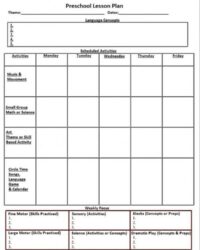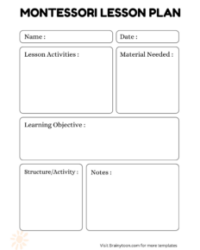Navigating the world of early childhood education can feel like a grand adventure, especially when you’re dedicated to creating a nurturing and stimulating environment for young minds. If you’re involved with a Montessori preschool, you already appreciate the unique philosophy that guides learning: fostering independence, concentration, and a genuine love for discovery in children. Crafting a cohesive and effective plan to support this incredible journey is key, yet it often presents a delightful challenge.
You might be wondering how to seamlessly integrate the child-led nature of Montessori into a structured plan, ensuring that every child receives the individualized attention and presentations they need. It’s not about rigid schedules, but rather about thoughtful preparation and observation. This article is designed to help you understand the core principles behind planning in a Montessori setting and how a well-designed template can become your best ally in creating a dynamic and engaging learning experience for every child.
Understanding the Montessori Approach to Planning
When we talk about lesson plans in a Montessori context, it’s a bit different from traditional schooling. Here, the "lesson" isn’t just a teacher delivering information; it’s often a carefully prepared presentation of materials that invites the child to explore and discover independently. The plan revolves less around what the teacher will teach today, and more about what environments and materials will be available, which children might benefit from specific presentations, and how their individual interests and developmental stages will be supported. It is deeply rooted in observation, making each child’s learning journey truly unique.
This distinction is crucial. Instead of following a strict curriculum day by day, a Montessori teacher meticulously prepares the environment, observing the children’s needs and readiness, and then offers individual or small-group presentations of the Montessori materials. These presentations are the "lessons." The effectiveness of these lessons relies heavily on the teacher’s understanding of each child and their ability to guide without interfering, allowing the child to absorb the concepts at their own pace. It’s a dance between structured preparation and fluid, responsive teaching.
The beauty of this method lies in its adaptability. While a traditional plan might outline a topic for the whole class, a Montessori plan considers where each child is in their development and what they are intrinsically motivated to learn next. This necessitates a flexible yet organized approach to planning. It’s about ensuring that the right materials are accessible, that new presentations are offered when a child shows readiness, and that there are opportunities for repetition and mastery.
Therefore, creating a comprehensive montessori preschool lesson plan template isn’t about filling in blanks for every minute of the day. It’s about designing a framework that allows for thoughtful consideration of the children, the prepared environment, and the presentations that will enrich their learning. It serves as a living document, evolving with the children’s progress and interests, allowing educators to maintain clarity and intention in their daily interactions and long-term goals for each child.
Key Elements of a Montessori Lesson Plan
To effectively plan in a Montessori environment, consider these vital components:
- Child Observations: Detailed notes on a child’s interests, developmental stage, challenges, and progress. This is the foundation of individual planning.
- Material Presentations: Specific lessons planned for individual children or small groups based on observations. This includes direct aims and indirect aims of the material.
- Follow-Up Activities: Ideas for reinforcing concepts introduced through presentations, perhaps through extended work or related materials.
- Prepared Environment Maintenance: Plans for rotating materials, ensuring accessibility, and tidying.
- Grace and Courtesy Lessons: Opportunities for modeling and practicing social skills.
Structuring Your Montessori Day
While the day is flexible, a basic structure often includes:
- Arrival and Greeting: Settling in, free choice of work.
- Work Cycle: The core of the Montessori day, with children engaging in self-chosen activities and receiving individual presentations.
- Group Time: Short periods for stories, songs, or grace and courtesy lessons.
- Outdoor Play: Time for gross motor development and connection with nature.
- Departure: Reflecting on the day and preparing to leave.
Crafting Your Personalized Lesson Plan Template
Creating a template that truly works for you and your Montessori environment involves understanding the flow of your classroom and the unique needs of your children. Think of your template not as a rigid rulebook, but as a dynamic tool that helps you organize your thoughts, track progress, and ensure a rich and stimulating experience for every child. It should provide enough structure to keep you organized, while also being flexible enough to adapt to the unpredictable yet wonderful nature of young learners.
The ideal template is one that you can easily refer to, update, and personalize. It should prompt you to consider not just what material to present next, but also which child is ready for it, what observations led you to that conclusion, and what the anticipated outcome might be. Remember, the true power of a Montessori lesson plan lies in its ability to support individual growth, not just cover a curriculum. It helps you stay attuned to each child’s inner guide, ensuring that your planning is responsive and respectful.
Your template will evolve as you become more familiar with your classroom dynamics and the children’s rhythms. Don’t be afraid to experiment with different layouts or sections until you find what truly aids your planning process. The goal is to simplify your work while maximizing the potential for learning and discovery in your prepared environment. A good template empowers you to be more present and responsive to the children, rather than constantly scrambling to remember what’s next.
- **Observe First:** Before planning, spend dedicated time observing children to understand their current interests and areas of focus.
- **Individualize Presentations:** Plan specific material presentations for individual children based on your observations, rather than a whole-group topic.
- **Document Progress:** Use your template to track which presentations a child has received and their level of mastery.
- **Plan for the Environment:** Include space to note materials that need to be rotated, cleaned, or prepared.
- **Reflect and Adjust:** Regularly review your plan and make notes on what worked well and what might need tweaking for the future.
- **Prioritize Flexibility:** Always remember that a Montessori plan is a guide, not a dictator. Be ready to follow the child.
Ultimately, the process of thoughtfully preparing your classroom and planning your interactions is incredibly rewarding. It allows you to cultivate an environment where children can truly thrive, developing independence, concentration, and a profound love for learning. By utilizing a clear and adaptable framework for your daily and weekly intentions, you’re not just managing a classroom; you’re nurturing the limitless potential within each and every child under your care, guiding them on their unique educational journey.


